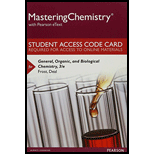
Concept explainers
a.
To identify:
If the given compounds are structural isomers, cis-trans isomers or enantiomers.
Concept introduction:
Structural isomers are those compounds that have same molecular formula but atoms are connected in a different manner in the structure.
Enantiomers are those compounds which contain atleast one carbon center and their mirror images are nonsuperimposable. These compounds are mirror images of one another.
Cis stereoisomers are those isomers in which two substitutent groups are present on the same side of the double bond in the given molecule. Trans stereoisomers are those isomers in which two substitutent groups are present on the opposite side of the double bond in the given molecule.
b.
To identify:
If the given compounds are structural isomers, cis-trans isomers or enantiomers.
Concept introduction:
Structural isomers are those compounds that have same molecular formula but atoms are connected in a different manner in the structure.
Enantiomers are those compounds which contain atleast one carbon center and their mirror images are nonsuperimposable. These compounds are mirror images of one another.
Cis stereoisomers are those isomers in which two substitutent groups are present on the same side of the double bond in the given molecule. Trans stereoisomers are those isomers in which two substitutent groups are present on the opposite side of the double bond in the given molecule.
c.
To identify:
If the given compounds are structural isomers, cis-trans isomers or enantiomers.
Concept introduction:
Structural isomers are those compounds that have same molecular formula but atoms are connected in a different manner in the structure.
Enantiomers are those compounds which contain atleast one carbon center and their mirror images are nonsuperimposable. These compounds are mirror images of one another.
Cis stereoisomers are those isomers in which two substitutent groups are present on the same side of the double bond in the given molecule. Trans stereoisomers are those isomers in which two substitutent groups are present on the opposite side of the double bond in the given molecule.
Want to see the full answer?
Check out a sample textbook solution
Chapter 4 Solutions
Mastering Chemistry with Pearson eText -- Standalone Access Card -- for General, Organic, and Biological Chemistry (3rd Edition)
- Which of the following statements is false? a. Molecules with the formulas CH3CH2COOH and C3H6O2 could be structural isomers. b. Molecules must have a double bond to be cis-trans isomers. c. To be enantiomers, a molecule must have at least three different atoms or groups connected to a central carbon. d. To be enantiomers, a molecule must have at least four different atoms or groups connected to a central carbon.arrow_forwardHow many chiral carbons does the following molecule contain?arrow_forwardwhat is the correct resonance hybrid for the compound with the condensed formula: CH2CHCHCHCH2+arrow_forward
 Chemistry & Chemical ReactivityChemistryISBN:9781337399074Author:John C. Kotz, Paul M. Treichel, John Townsend, David TreichelPublisher:Cengage Learning
Chemistry & Chemical ReactivityChemistryISBN:9781337399074Author:John C. Kotz, Paul M. Treichel, John Townsend, David TreichelPublisher:Cengage Learning Chemistry for Today: General, Organic, and Bioche...ChemistryISBN:9781305960060Author:Spencer L. Seager, Michael R. Slabaugh, Maren S. HansenPublisher:Cengage Learning
Chemistry for Today: General, Organic, and Bioche...ChemistryISBN:9781305960060Author:Spencer L. Seager, Michael R. Slabaugh, Maren S. HansenPublisher:Cengage Learning Chemistry: Principles and PracticeChemistryISBN:9780534420123Author:Daniel L. Reger, Scott R. Goode, David W. Ball, Edward MercerPublisher:Cengage Learning
Chemistry: Principles and PracticeChemistryISBN:9780534420123Author:Daniel L. Reger, Scott R. Goode, David W. Ball, Edward MercerPublisher:Cengage Learning Organic And Biological ChemistryChemistryISBN:9781305081079Author:STOKER, H. Stephen (howard Stephen)Publisher:Cengage Learning,
Organic And Biological ChemistryChemistryISBN:9781305081079Author:STOKER, H. Stephen (howard Stephen)Publisher:Cengage Learning, General, Organic, and Biological ChemistryChemistryISBN:9781285853918Author:H. Stephen StokerPublisher:Cengage Learning
General, Organic, and Biological ChemistryChemistryISBN:9781285853918Author:H. Stephen StokerPublisher:Cengage Learning




